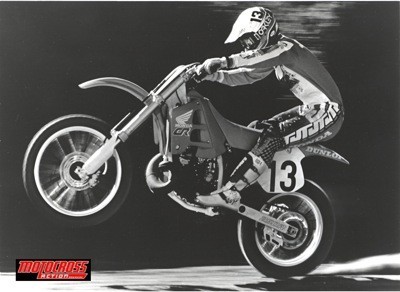MOTOCROSS ACTION MID-WEEK REPORT

Yesterday at 02:30 PM
#WHIPITWEDNESDAY
Rider: Justin Bogle
Justin Bogle was always a rider known for his incredible style on the bike but also had the results to prove his skill. As an amateur Justin was one of the riders that was feared when showing up to a national for a week of racing. Winning multiple championships through his upbringing he was destined to become a great pro. He raced for the first time at Loretta Lynns on 50cc’s but his first win did not come until ten years later when he won the B class. He would continue winning through the A class and secure a deal with Geico Honda. With the Geico Honda team, he would go on to win one championship in the 250 East region. He did have results up front in the 450 class but would slowly fall off the pace. Now Justin is riding the new Stark Varg electric bikes and is going to be racing Arenacross this year.
LIAM EVERTS JOINS NESTAAN HUSQVARNA FACTORY RACING
Nestaan Husqvarna Factory Racing is excited to announce that Liam Everts, one of Motocross’ brightest young talents, will join the team for the 2025 MX2 season. Everts will race alongside reigning MX2 World Champion Kay de Wolf, forming a duo that promises to take the FIM MX2 Motocross World Championship by storm.
Liam Everts, aged 20, hailing from Hasselt in Belgium, carries a prestigious motocross pedigree as the son of ten-time world champion Stefan Everts and the grandson of four-time world champion Harry Everts. While his family’s legacy has undoubtedly shaped his early career, Liam’s own accomplishments are now speaking for themselves.
RACING THE GNARLIEST SAND GP IN THE USA
MXA PHOTO TRIVIA
Who is this rider? The answer will be at the bottom of the article.
GLEN HELEN’S NEW RACE: $100,000 PRIVATEER CHALLENGE EXPLAINED
ASK THE MXPERTS: WHAT’S SO SPECIAL ABOUT A DESMO ENGINE?
THE LUCY AND DESMO SHOW
Dear MXperts,
Can you explain what makes a desmo engine so highly regarded when no one can tell me what makes a desmo engine different from any other four-stroke?
Back in the 1950s, Fabio Taglioni, the world’s greatest motorcycle engineer, pioneered the desmo valve train. It was one of the most groundbreaking inventions of the time. Prior to the 1950s, four-stroke engines could not rev above 10,000 rpm. Why not? The valve springs of that era were not strong enough to withstand high rpm and broke as engine rpm soared.
Most modern four-stroke motocross bikes rely on increased rpm to make horsepower, but the valve spring issue stymied the effort. Just as bad as valve-spring breakage was valve float. “Valve float” referred to the valve springs not being able to keep up with the cam lobes, so the valves floated somewhere in the middle of their opening curve. Manufacturers of the 1950s tried every cure they could think of to keep the valves from breaking or floating, but no matter what they tried, they couldn’t get above 12,000 rpm. That’s when Fabio Taglioni introduced the desmo valve train and broke the rpm barrier.
“Desmo” is short for “desmodromic,” and it refers to the way that a four-stroke valve inside of an engine is controlled. Every four-stroke motorcycle engine’s valves are opened by the camshaft lobe and closed by the spring pressure of the metal valve spring. It is the dominant system because it works, is inexpensive to build and is simple to work on. A desmodromic valve train eliminates broken springs and valve float by eliminating the spring. The valves are opened via the cam lobe and closed by an additional cam lobe that operates an L-shaped lever that positively pulls the valve closed.
It is simple because one cam lobe opens the valve and a second cam lobe closes the valve. Desmodromic valves were the rage in the 1950s. In fact, the famous straight-eight, W196, Mercedes-Benz Formula 1 cars had desmo valve trains. Ducati’s first desmo engine was the 1956 125cc Grand Prix road race bike.
Today, only Ducati still races with the desmodromic system, largely because the valve-spring issues have been eliminated by pneumatic valves that work off air pressure to close the valves. Pneumatic valves make it possible to shorten the valve’s open time and increases lift, which enables the engine to rev as high as 20,000 rpm.If and when the Ducati 450MX comes with its highly developed desmo system, the 450MX engine’s valves will offer short-duration, higher-lift cam profiles that will produce a torque band that is very wide. But, it won’t be the first desmodromic production motocross bike sold in the United States, because that honor belongs to the 1971 Ducati 450 R/T Desmo—a one-year model that suffered from frame issues that kept its desmodromic powerplant from living up to its potential.
FLY RACING JOINS FACTORY KTM RACING
QUOTE OF THE WEEK: COLTON HAAKER AND ROCKSTAR ENERGY HUSQVARNA FACTORY RACING FINISH RUNNER-UP AT REDMOND
“Redmond was good for me,”Haaker said.”In the final race it was really dependant on the start – there wasn’t much else that I could do. I tried to go outside of the main lines, but they were slower than the best line. The best I could do was to be there and look to capitalize on a mistake, but Trystan didn’t make one in the end.”.
MXA PHOTO OF THE WEEK
MXA’s Josh Mosiman (22) riding the 2025 YZ450F during the World Vet Championships in the 25+ expert class. Josh would finish second overall with 1-2-2 scores in the three-moto format.
CLASSIC MXA PHOTO
Rick Johnson riding a CR250 back in 1990, giving the MXA camera a little wheelie as he speeds down a straight.
MXA Photo Trivia Answer: David Bailey who during his eight-year professional motocross career, Bailey won 30 AMA national race victories and won three motocross national championships.
The post MOTOCROSS ACTION MID-WEEK REPORT appeared first on Motocross Action Magazine.


